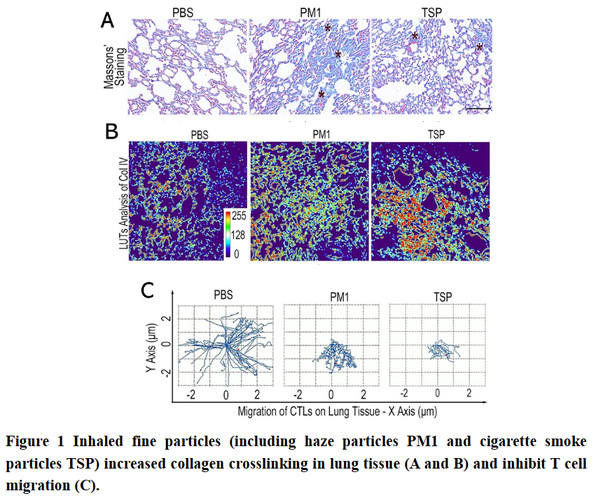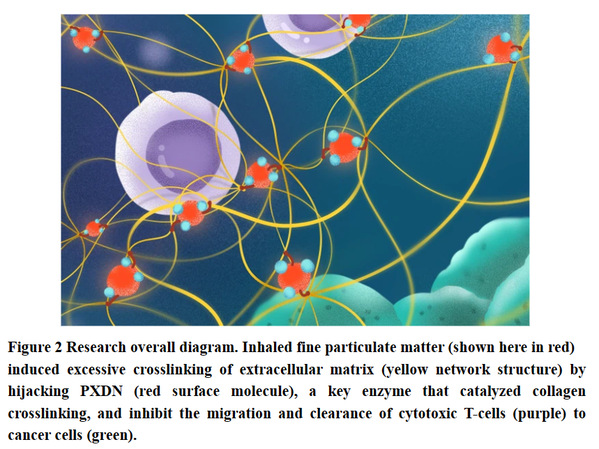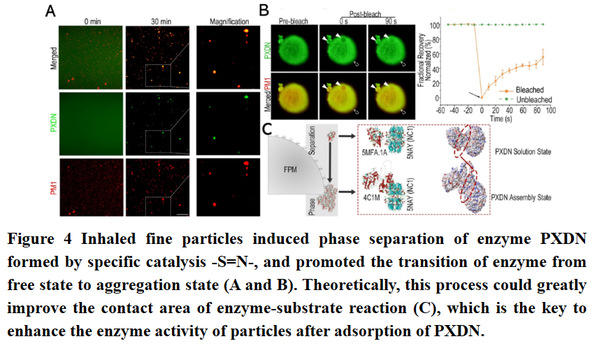Epidemiological studies have shown that long-term exposure to respirable fine particulate matter (FPM) such as PM2.5, PM1, and cigarette smoke particles in haze is closely related to the occurrence of lung cancer. Every 10 μg/m3 increase in FPM concentration is associated with an 8% increase in the likelihood of lung cancer. Despite the implementation of a series of environmental management initiatives, domestic air quality has improved significantly in recent years, with the average exposure concentration of FPM reduced to 30 μg/m3 from nearly 100 in previous years; however, this is still well above the WHO published safety range (10 μg/m3). This shows the potential biohazard of respirable fine particulate matter will persist for some time.
Current research on the carcinogenesis of FPM mainly focuses on the gene mutation induced by particulate matter. But it is a complicated and long-term process from the appearance of tumor cells to their development into tumor. Organism could utilize innate immune defense, such as such as cytotoxic T lymphocyte (CTLs), to eliminate most early-stage tumor cells in time to avoid tumorigenesis. How FPM assist tumor cells to evade immune surveillance and defense and eventually form tumor is the key to elucidate the mechanism of environmental pollution particles promoting the occurrence and development of lung cancer, and is helpful to search for new specific preventive drugs. Recently, Lei Dong and Junfeng Zhang from the School of Life Sciences, Nanjing University and the State Key Laboratory of Pharmaceutical Biotechnology, and Chunming Wang from University of Macau made important progress in tumor biology.
First, the authors analyzed the correlation between lung cancer occurrence and early lung immune defense after exposure to FPM. They verified the promoting effect of FPM exposure on the lung tumorigenesis in transgenic mouse models of primary and secondary lung cancer. Meanwhile, the authors monitored CTLs in lung tissues of two lung carcinoma mice models at different stages of development and found FPM exposure lead to insufficient recruitment of CTLs in the early stage, which greatly weakened the killing ability of lung CTLs to tumor cells. Therefore, the relatively loose immune defense environment caused by FPM is the core to the promotion of lung tumor progression by particulate matter.
Next, the study analyzed how FPM interfered with the infiltration and killing activity of lung CTLs. In general, lung tissue would issue an early warning mechanism to recruit CTLs and other immune cells when tumor cells appear. The migration of lung CTLs is mainly dependent on the path provided by the extracellular matrix. Through a real-time dynamic tracking of CTLs, the authors found the blocked migration of CTLs was due to the changes of lung interstitial structure induced by FPM exposure (Figure 1). FPM could induce excessive crosslinking of local extracellular matrix and block the migration path of CTLs. The blocked migration path would increase or set a physical barrier for the direct contact between immune cells and cancerous cells, thus weakening the local immune defense ability of lung tissue (Figure 2).


induced excessive crosslinking of extracellular matrix (yellow network structure) by hijacking PXDN (red surface molecule), a key enzyme that catalyzed collagen crosslinking, and inhibit the migration and clearance of cytotoxic T-cells (purple) to cancer cells (green).
Then, this study analyzed how FPM affected the crosslinking of extracellular matrix. The authors explored the effect of FPM on the degree, mode and site of in the extracellular matrix crosslinking, and found FPM mainly acted by increasing sulfilimine bond (-S=N-) at the crosslinking site. This biological activity of FPM is derived from the peroxidasin PXDN adsorbed by particulate matter from lung tissue (Figure 3). PXDN specifically catalyzed the formation of -S=N-, and FPM adsorption significantly increased the enzyme activity of PXDN, thus improving the degree of crosslinking of extracellular matrix. Further mechanism studies showed that the increased activity of PXDN enzyme was related to the phase transition from the free state to the aggregate state after adsorption on the surface of FPM (Figure 4). Through protein 3D modeling of enzyme and substrate molecular simulation docking, the authors found the phase transition of PXDN increased the interface where enzymes react with substrates, which provided a strong theoretical explanation and support for the increase of PXDN enzyme activity after particulate adsorption. After identifying PXDN as the molecular target of FPM to accelerate the lung tumor progression, the authors attempted to utilize shRNA of PXDN and small molecule inhibitors (phloroglucinol and methimazole) for prophylaxis. And these drugs could significantly reduce the incidence of lung cancer after exposure to FPM.


In summary, this study further elucidated the mechanism of inhaled fine particles in the early stage of lung cancer, identified the key biological reaction nodes of pathological changes induced by such pollutants and revealed the regulatory role of particulate matter in the biological interface. It provided a new explanation for the mechanism of tumor induced by particulate matter and proposed a new effective molecular target for drug therapy.
This study, titled Air Pollution Particles Hijack Peroxidasin to Disrupt Immunosurveillance and Promote Lung Cancer was published online in eLife, the leading academic journal in the field of biology published by eLife Sciences, on April 19, 2022. Meanwhile, the magazine focused the news on the article. Zhenzhen Wang, associate professor of the School of Life Sciences, is the first author of the article. Master Ziyu Zhai and Chunyu Chen and Dr. Xuejiao Tian and Zhen Xing participated in the study. Dr. Yushun Yang provided a strong support for 3D modeling. The study was funded by the National Natural Science Foundation of China, the Natural Science Foundation of Jiangsu Province and the Amental Research Funds for the Central Universities.
Article link::https://prod--journal.elifesciences.org/articles/75345
eLife news report link:
https://prod--journal.elifesciences.org/for-the-press/d29e5b60/how-air-pollution-alters-lung-tissue-increasing-cancer-susceptibility
